The onshore transmission network in Scotland is owned by SSEN Transmission and SP Transmission.
The Scottish NETS is divided into 7 boundaries:
- B0 – Upper North SSEN Transmission
- B1a – North West SSEN Transmission
- B2 – North to South SSEN Transmission
- B3b – Kintyre and Argyll SSEN Transmission
- B4 – SSEN Transmission to SP Transmission boundary (shared by SSEN Transmission and SP Transmission)
- B5 – North to South SP Transmission
- B6 – SP Transmission to NGET (shared by SP Transmission and National Grid Electricity Transmission)
The map below shows the general pattern of power flow directions expected to occur most of the time in the years to come up to 2033, i.e. power will generally flow from north to south. The arrows in the diagram illustrate power flow directions and are approximately scaled relative to the winter peak flows.
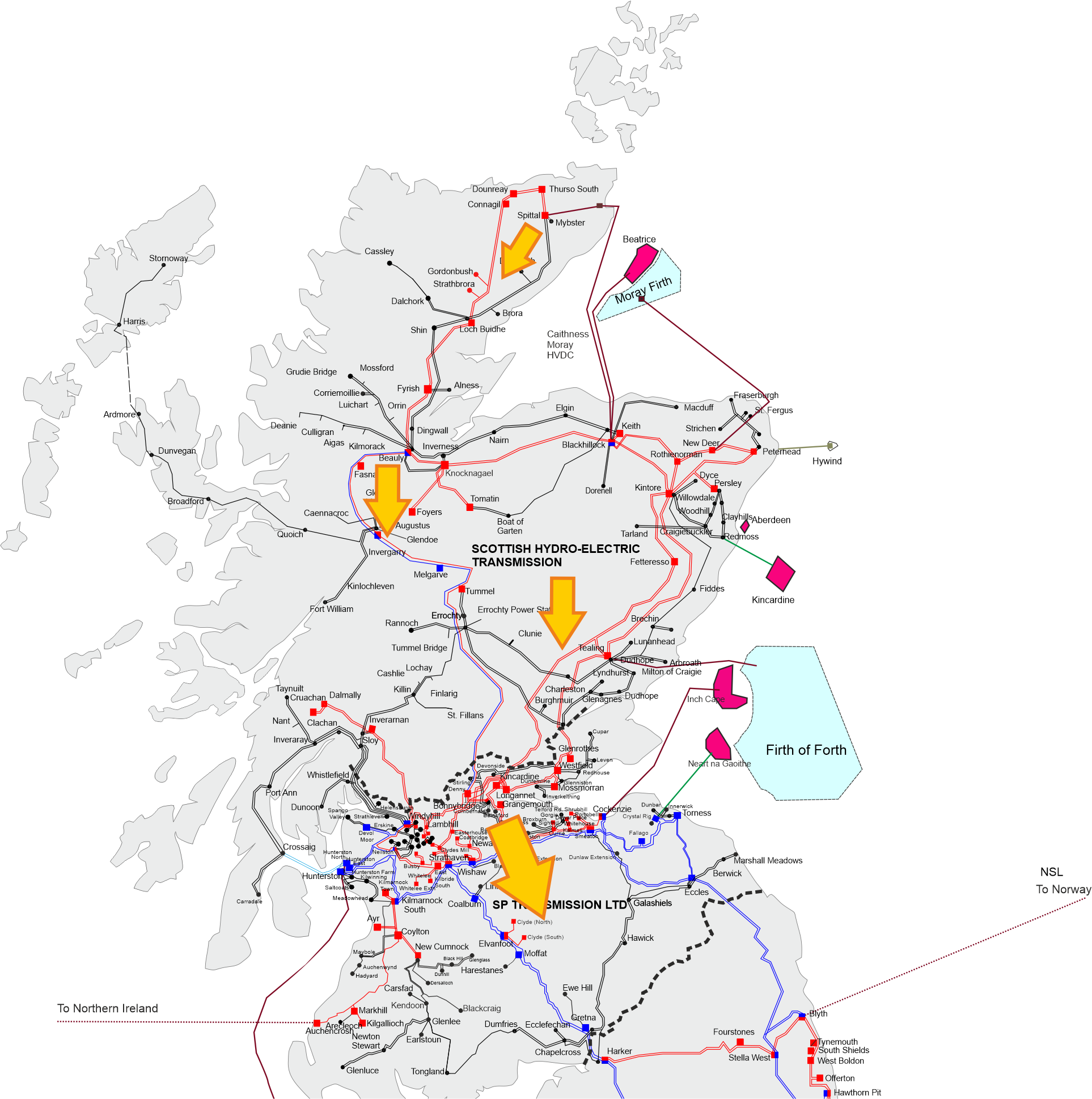
Regional thermal drivers – Scotland
Scotland continues to experience a significant increase in renewable generation capacity due to its abundant availability of natural resources, often in areas where the transmission network is limited.
Over the next ten years, this swift growth in renewable generation capacity, mainly from offshore wind, will substantially contribute to greater power transfer requirements across the Scottish boundaries. This will increase the network reinforcement needs across some boundaries.
Scotland’s current winter peak gross demand is 4GW, rising to approximately 6GW by 2030. Its generation capacity is 17.8GW, rising to approximately 43GW in the Leading the Way scenario by 2030. Across all the ESO’s Future Energy Scenario modelling, generation capacity of fossil fuel in Scotland reaches almost zero between 2030-2035. Generation capacity in Scotland heavily exceeds demand and thus Scotland will be expected to export power into England most of the time, except during periods of prolonged low wind, where the reverse may occur.
As Scotland’s renewable generation over the next ten years increases, so too does the power transfer requirements across the Scottish boundaries increase as a result (the Scottish NETS boundaries are B0, B1a, B2, B3b, B4 and B5 and B6). This will increase the network reinforcement needs across some boundaries.


With the anticipated generation development in the north of Scotland, including on the Western Isles, Orkney and the Shetland Islands, there may be local limitations on power transfer from these remote locations to the main transmission routes (B0, B1a). Ofgem included a 1.8GW Western Isles transmission link as part of the Accelerating Strategic Transmission Investments (ASTI) decision, which will alleviate some of these limitations, facilitating the transfer of renewable generation to the mainland.
The decline in synchronous generation (primarily from fossil fuel generation) in Scotland could result in low short circuit level and inertia system operability challenges. To overcome this, the NOA Stability Pathfinder Phase 2 has successfully procured cost effective services which will meet our short-circuit level and inertia needs in the Scottish region. Contracts were awarded mid-2022.
Alongside needed network reinforcements to address the constraints across the B6 boundary (Anglo-Scottish border), the ESO has developed and procured a commercial non-build solution, the B6 Constraint Management Intertrip Service (CMIS), to help alleviate constraints. This has contracted with generators (totalling 2GW in capacity) in the region to provide a more economical method of managing constraints than actions through the balancing mechanism. After going live in April 2022, this service has provided savings to the consumer of £80m in constraint costs during its first ten months of operation.
As the ESO enters the next phase of our network planning cycle with the Transmission Owners and other interested parties (the TCSNP2), we will assess the need for any new network reinforcement to address the above-mentioned issues. Following this next network options assessment, recommendations on potential reinforcements or non-network build solutions for the Scottish region will be published.
Regional voltage drivers – Scotland
Scotland has seen a decline in synchronous generation that currently limits the local generation available to support the local voltage.
Over the next decade, there is a significant growth in renewable generation expected in Scotland however, this is located at the peripherals of the network and would not be effective at managing voltages into central Scotland.
The decline in synchronous generation, primarily from fossil fuel generation, in Scotland could result in low short circuit level and inertia system operability challenges. To overcome this, the NOA Stability Pathfinder Phase 2 has successfully procured cost effective services which will meet our short-circuit level and inertia needs in the Scottish region, these solutions can also support voltage in the area and contracts were awarded mid-2022. We expect two synchronous compensators and two grid forming battery storage devices from 2024 and one additional grid forming battery storage device from 2025 and 2026 in Central Scotland region as part of Stability Pathfinder Phase 2 project.
The map to the right shows South Central Scotland identified through our voltage screening process.

Download a larger vesion of this image
Boundary regions
Click on the regions below to expand the boundary and understand its capability and challenges.
The graphs show a distribution of power flows for each of our Future Energy Scenarios, in addition to the boundary power transfer capability and NETS SQSS requirements for the next 20 years.
Each scenario has different generation and demand so produces different boundary power flow expectations. From applying the methodology in the NETS SQSS for wider boundary planning requirements (as discussed in the previous chapter), we determine for each scenario:
- The economy criteria - solid coloured line
- Security criteria - dashed coloured line
- Current and future NOA capability (where available) - solid red line
The capability line (red line) is based on the recommendations from the Beyond 2030 report. More information about the NOA methodology can be found here. The 50%, 90%, economy required transfer (RT) and Security RT are calculated from the 2023 FES and ETYS processes. Where the NOA transfer capability is not available, there is a red line that provides the transfer capability from ETYS 2022.
Note: Boundary capability line is affected by the generation and demand profiles within each FES background. Therefore, the graphs are provided for indicative purposes only and cannot be directly compared.
The calculations of the annual boundary flow are based on unconstrained market operation, meaning network restrictions are not applied. This way, the minimum cost generation output profile can be found. We can see where the expected future growing needs could be by looking at the power flows in comparison with boundary capability.

View an interactive version of the graph
On each graph, the two shaded areas provide confidence as to what the power flows would be across each boundary:
- The darker region shows 50% of the annual power flows
- The lighter region shows 90% of the annual power flows
From the regions, we can show how often the power flows expected in the region split by the boundary are within its capability (red line). If the capability of the boundary is lower than the two regions over the next 20 years, there might be a need for reinforcements to increase the capability. However, if the line is above the shaded regions, it shows that there should be sufficient capability here and that potentially no reinforcements are needed from a free market power flow perspective until the shaded regions exceed the capability (red line).
Highlighted yellow areas on our NETS regional diagrams will show areas identified through our voltage screening process on the NETS that could face voltage needs over the next ten years. These areas have been identified through our annual voltage screening process outlined in our "About the ETYS" section and is included in our NOA methodology. These charts will be accompanied by a general commentary surrounding voltage behaviour in the regional area.

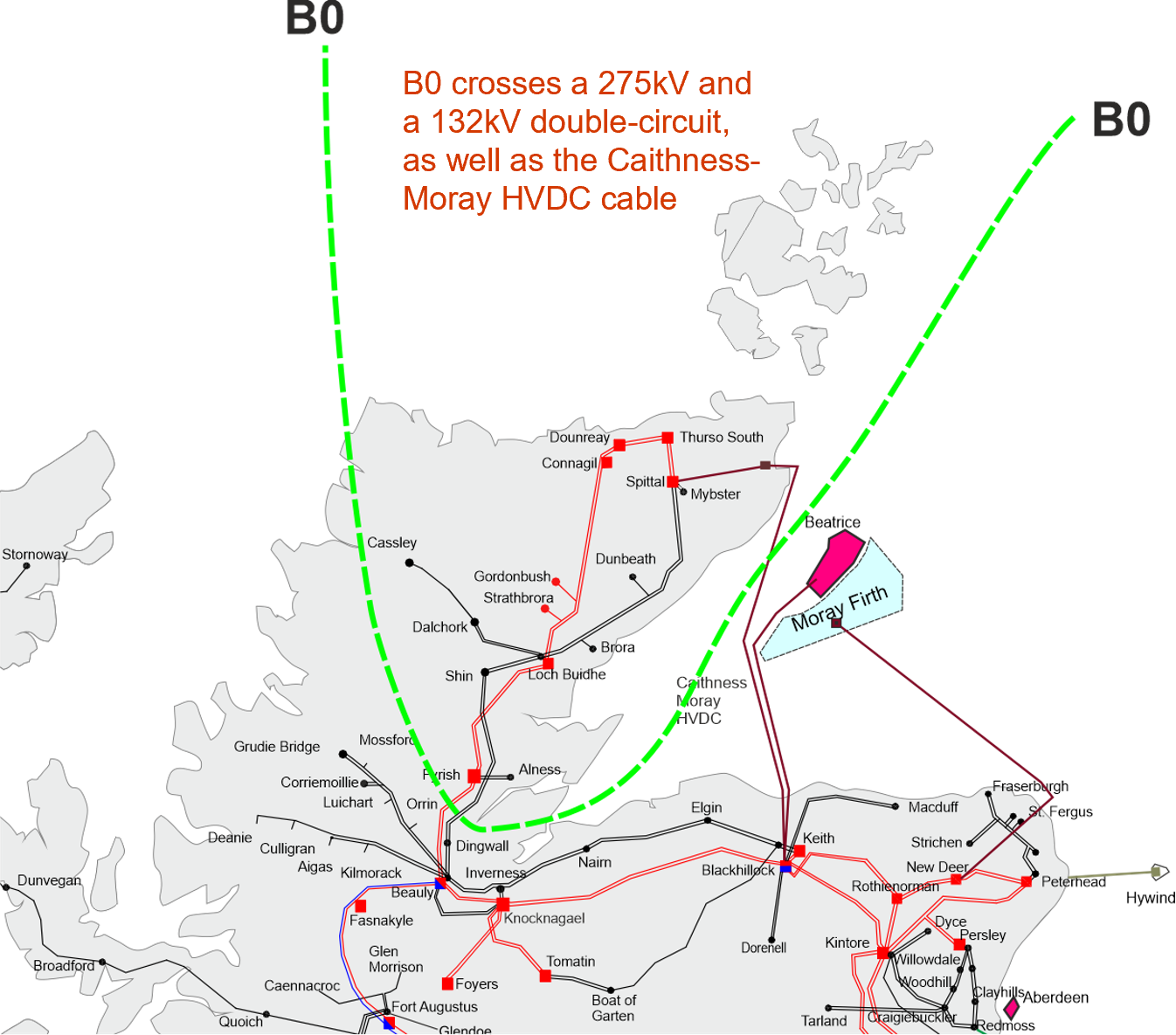
Boundary B0 separates the area north of Beauly, comprising the north of the Highlands, Caithness, Sutherland and Orkney.
Boundary flows and base capability

View an interactive version of the graph
The capability line (in red) is based on the recommendations from the NOA 2021/22 optimal path which uses the 2021 FES and ETYS data as inputs. The 50%, 90%, Economy RT and Security RT lines are based on FES 2023. The ETYS and NOA methodologies for this boundary are different and can result in different transfer capabilities.
The boundary capability is limited to 1.15GW due to a thermal constraint on the Beauly–Shin 132kV circuit.
The power transfer through B0 is increasing due to the substantial growth of renewable generation north of the boundary. This generation is primarily centred around both onshore and offshore wind. There is also the prospect of new marine generation resource in the Pentland Firth and Orkney waters in the longer term.
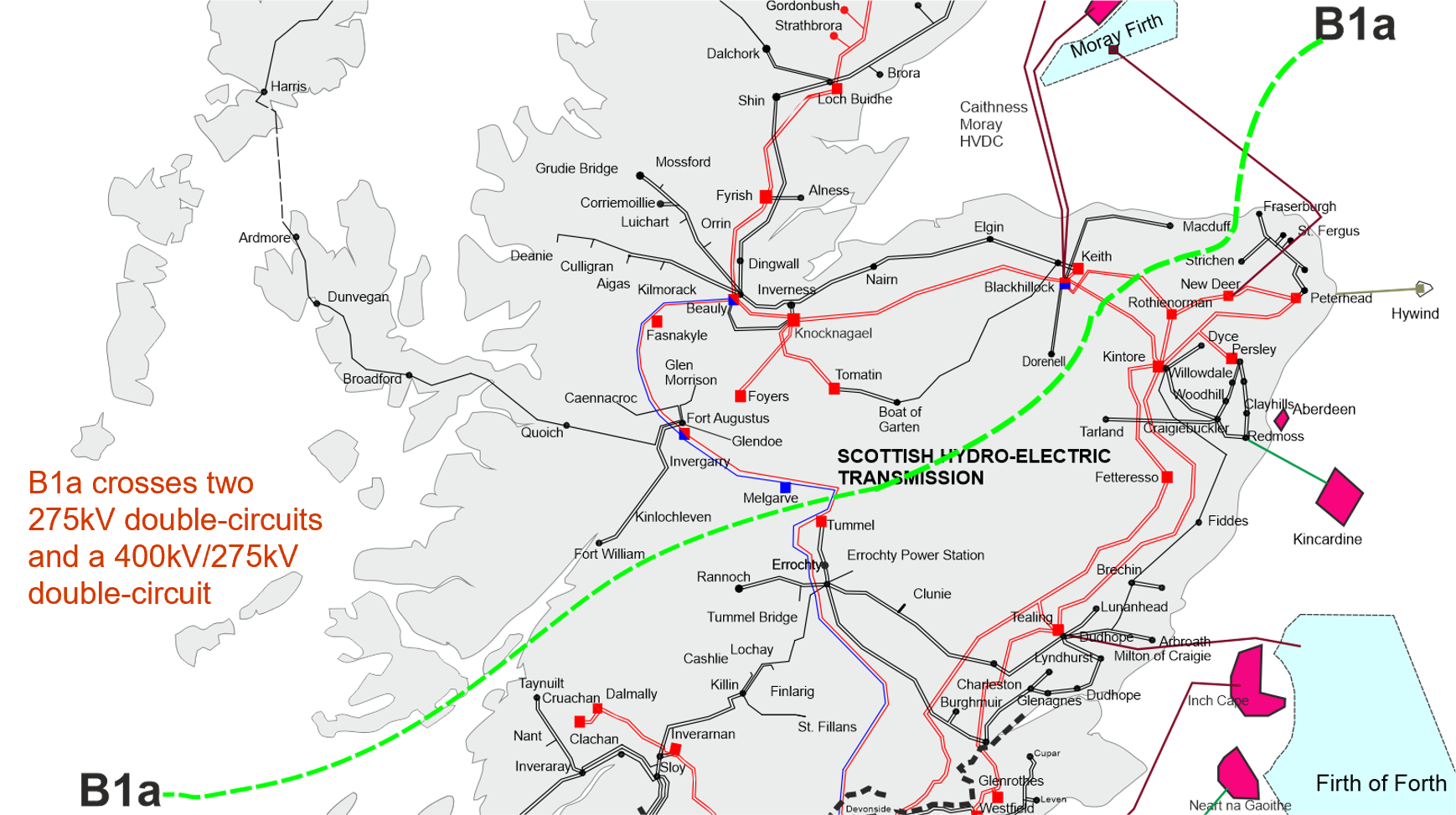
Boundary B1a runs from the Moray coast near Macduff to the west coast near Oban, separating the north west of Scotland from the southern and eastern regions.
Boundary flows and base capability

View an interactive version of the graph
The capability line (in red) is based on the recommendations from the Beyond 2030 report, which uses the 2023 FES and ETYS data as inputs. The 50%, 90% Economy RT and Security RT lines are based on FES 2023. The ETYS and NOA methodologies for this boundary are different and can result in different transfer capabilities.
The boundary capability is currently limited to 1.7GW due to a thermal constraint on the Errochty–Killin 132kV circuit.
New renewable generation connections north of the boundary are expected to result in a significant increase in export requirements across the boundary, especially along the Beauly–Denny circuit. All generation north of boundary B0 also lies behind boundary B1a.
In all the future energy scenarios, there is an increase in the power transfer through B1a due to the large volume of renewable generation connecting to the north of this boundary. Although this is primarily onshore wind and hydro, there is the prospect of significant additional offshore and onshore wind, wave and tidal generation resources being connected in the longer term. Contracted generation behind boundary B1a includes the renewable generation on the Western Isles, Orkney and the Shetland Isles with a considerable volume of large and small onshore wind developments. Future connection of several new pumped storage assets in the north west of the country is planned.
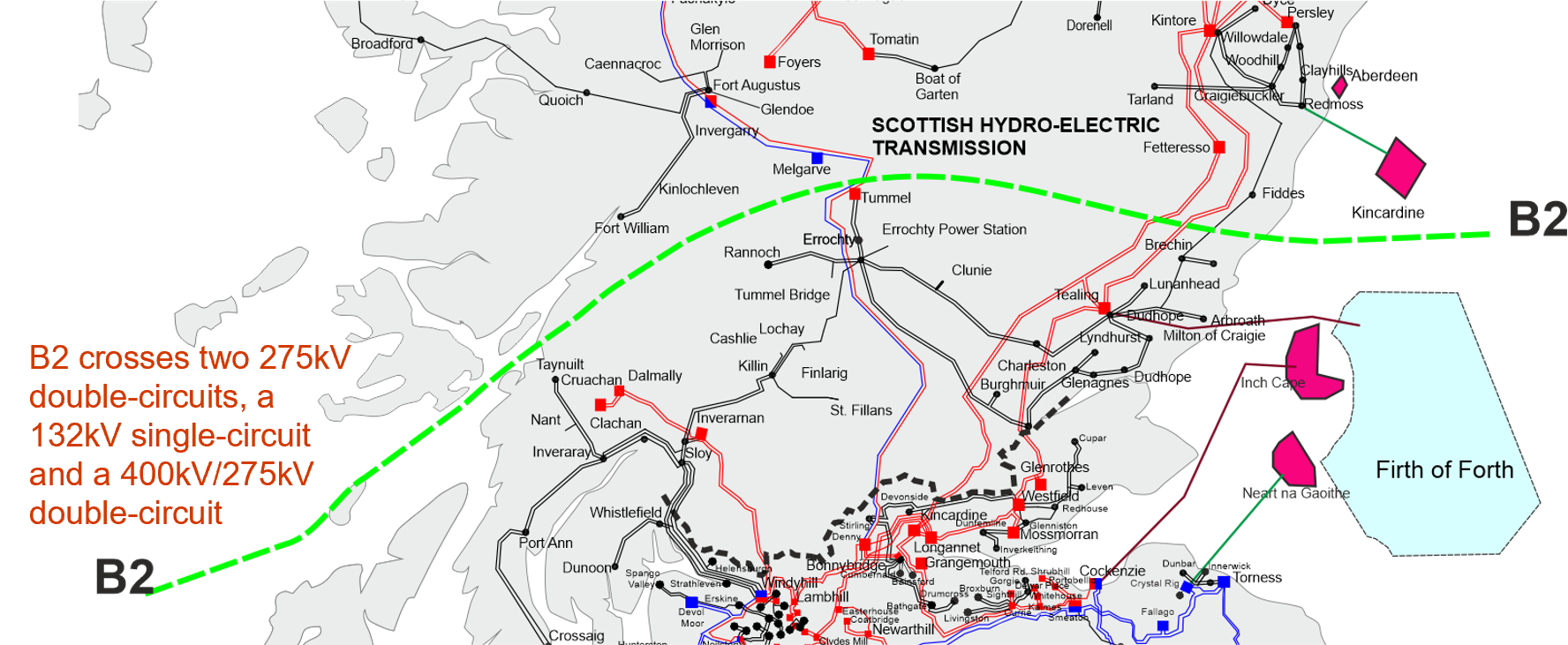
Boundary B2 cuts across the Scottish mainland from the east coast between Aberdeen and Dundee to near Oban on the west coast crossing the main north-south routes from the north of Scotland.
Boundary flows and base capability

View an interactive version of the graph
The capability line (in red) is based on the recommendations from the Beyond 2030 report, which uses the 2023 FES and ETYS data as inputs. The 50%, 90% Economy RT and Security RT lines are based on FES 2023. The ETYS and NOA methodologies for this boundary are different and can result in different transfer capabilities.
The boundary capability is currently limited to 2.6GW due to a thermal constraint on the Fetteresso–Kincardine 275kV circuit.
The generation behind boundary B2 includes both onshore and offshore wind, with the potential for additional pumped storage. Thermal generation lies between boundaries B1a and B2, as do several offshore windfarms and the proposed future HVDC interconnection to Norway.
The potential future boundary transfers for boundary B2 are increasing at a significant rate because of the high volume of renewable generation to be connected to the north of the boundary. This increased generation capacity will drive increasing power flows down the east coast 275kV circuits.
The increase in the required transfer capability for this boundary across all generation scenarios indicates the strong potential need to reinforce the transmission system.
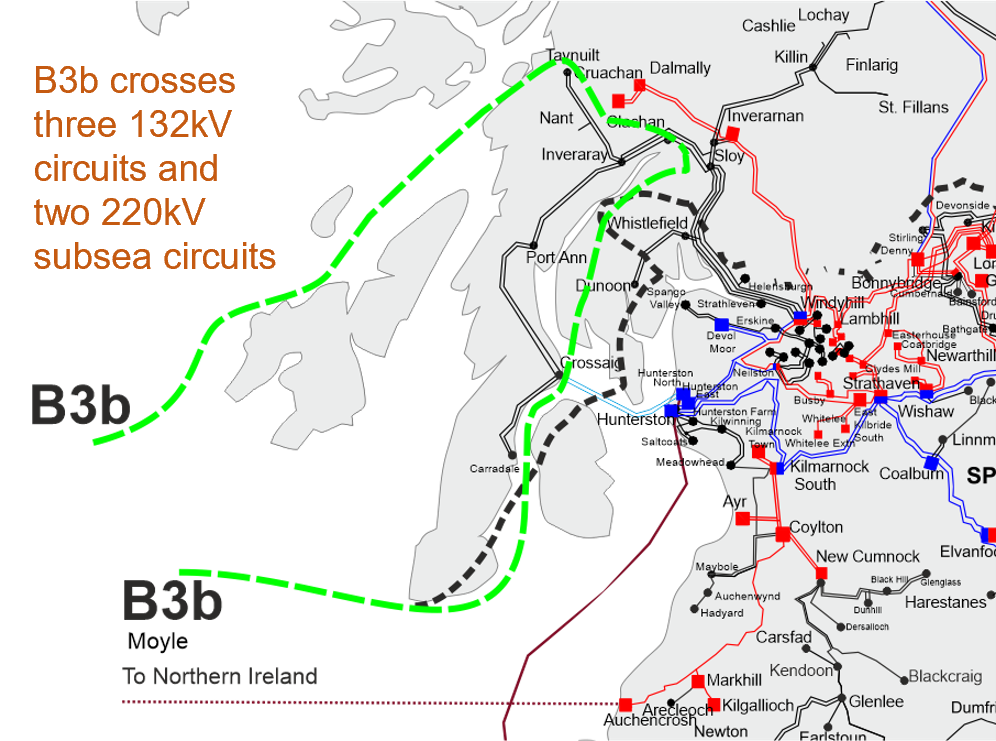
Boundary B3b encompasses the Argyll and Kintyre peninsula, and boundary assessments are used to show limitations on the generation power flow out of the peninsula.
Boundary flows and base capability

View an interactive version of the graph
The capability line (in red) is based on the ETYS base (year 1) transfer capability, using the 2022 FES and ETYS data as inputs. The 50%, 90% and Economy RT lines are based on FES 2023. The ETYS and NOA methodologies for this boundary are different and can result in different transfer capabilities.
The boundary capability is limited to 0.44GW due to a thermal constraint on the Inveraray - Sloy 132kV circuit.
The generation within boundary B3b includes both onshore wind and hydro generation, with the prospect of further wind generation resource and the potential for marine generation being connected in B3b in the future, triggering the requirement for future reinforcement of this network.
B3b is not currently subject to NOA reinforcement options as current contracted enabling works for customer connections will increase the ability to export power from this region, effectively splitting the network in the south west and altering the boundary.
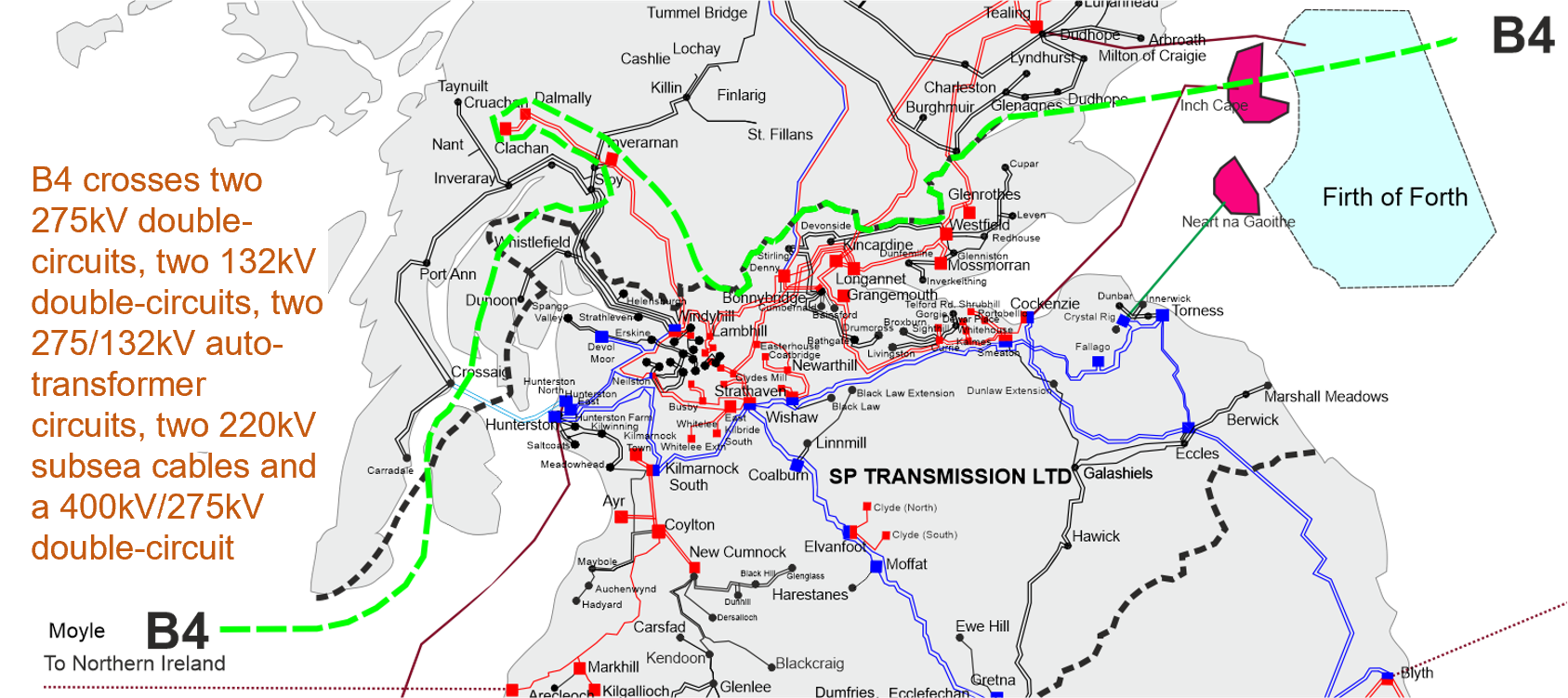
Boundary B4 separates the transmission network at the SP Transmission and SSEN Transmission interface running from the Firth of Tay in the east to the north of the Isle of Arran in the west.
Boundary flows and base capability

View an interactive version of the graph
The capability line (in red) is based on the recommendations from the Beyond 2030 report, which uses the 2023 FES and ETYS data as inputs. The 50%, 90% Economy RT and Security RT lines are based on FES 2023. The ETYS and NOA methodologies for this boundary are different and can result in different transfer capabilities.
The boundary capability is limited to 3.4GW due to a thermal constraint on the Westfield–Longannet 275kV circuit.
With increasing generation and potential interconnectors in the SSEN Transmission area for all scenarios, the required transfer across boundary B4 is expected to increase significantly over the ETYS period.
In all scenarios in the FES, the power transfer through boundary B4 increases because of the significant volumes of generation connecting north of the boundary, including all generation above boundaries B0, B1a, B2 and B3b. This is primarily onshore and offshore wind generation, with the prospect of significant further offshore wind and new marine generation resource being connected in the longer term.
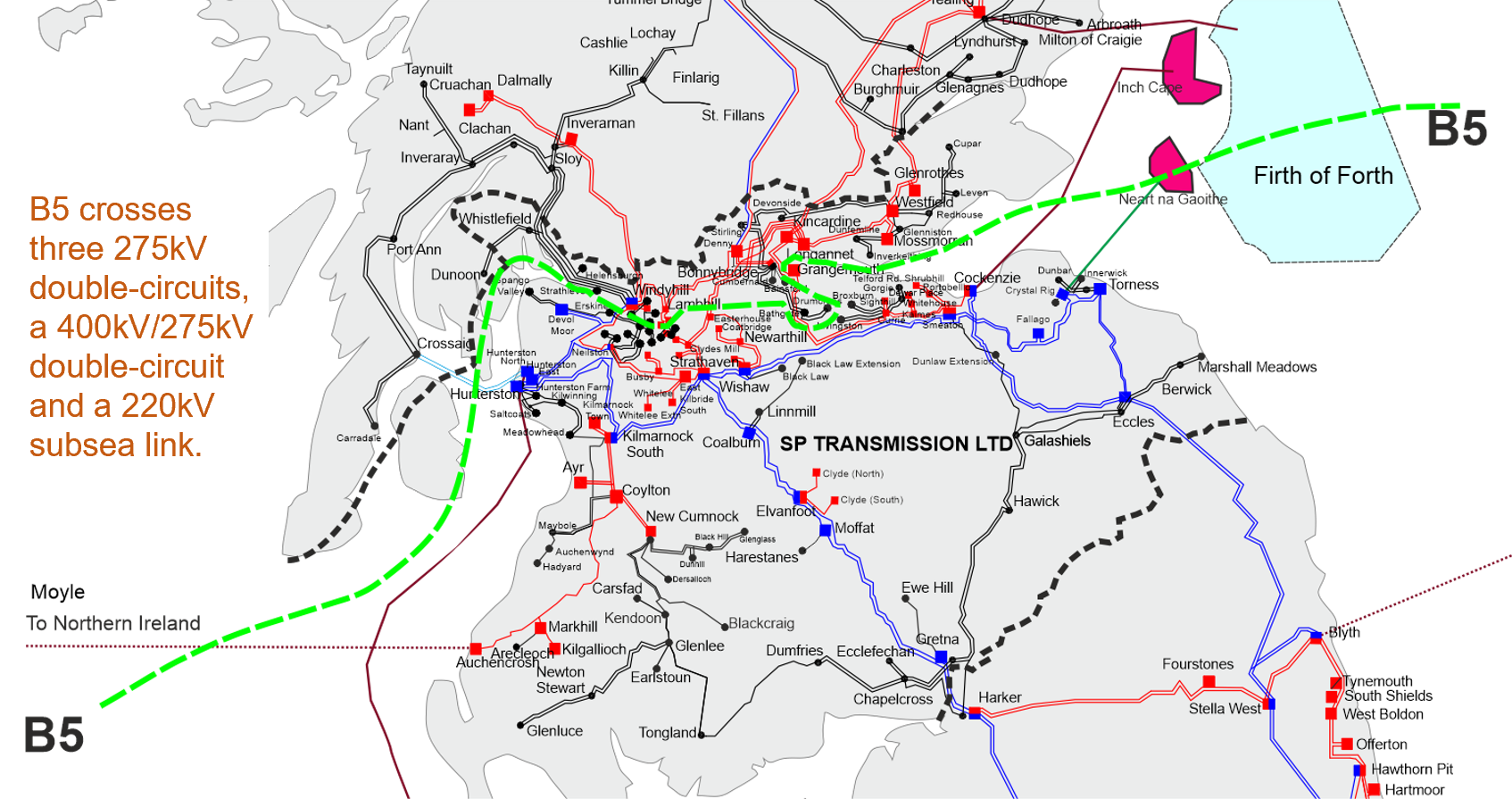
Boundary B5 is internal to the SP Transmission system and runs from the Firth of Clyde in the west to the Firth of Forth in the east.
Boundary flows and base capability

View an interactive version of the graph
The capability line (in red) is based on the recommendations from the Beyond 2030 report, which uses the 2023 FES and ETYS data as inputs. The 50%, 90% Economy RT and Security RT lines are based on FES 2023. The ETYS and NOA methodologies for this boundary are different and can result in different transfer capabilities.
The boundary capability is limited to 3.9GW due to a thermal constraint on the Kincardine–Tealing 275kV circuit.
In all the scenarios in the FES, the power transfer through boundary B5 increases because of the significant volumes of generation connecting north of the boundary, including all generation above boundaries B0, B1a, B2 and B4. This is primarily onshore and offshore wind generation.
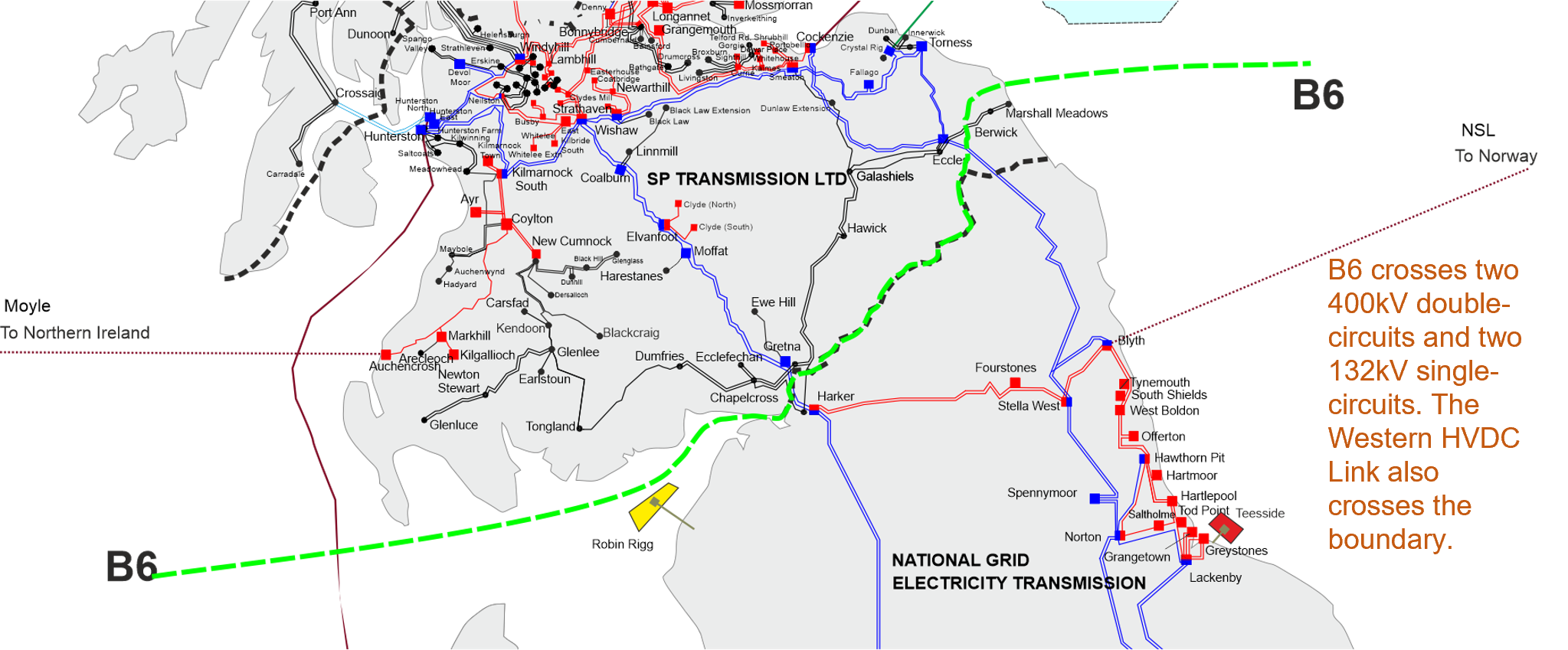
Boundary B6 separates the transmission network at the SP Transmission and National Grid Transmission interface running roughly along the border between Scotland and England.
Boundary flows and base capability

View an interactive version of the graph
The capability line (in red) is based on the recommendations from the Beyond 2030 report, which uses the 2023 FES and ETYS data as inputs. The 50%, 90% Economy RT and Security RT lines are based on FES 2023. The ETYS and NOA methodologies for this boundary are different and can result in different transfer capabilities.
The boundary capability is limited to 6.3GW due to a thermal constraint on the Harker–Moffat 400kV circuit.
Across all FES, there is an increase in the power transfer requirements from Scotland to England due to the connection of additional generation in Scotland, primarily onshore and offshore wind.
With the FES including many wind farms in Scotland, the spread of boundary power flows is very wide due to the intermittent nature of wind generation. With low generation output in Scotland, it is credible to have power flowing from south to north feeding Scottish demand.
The magnitude of the south to north power flows is low compared to those in the opposite direction so network capability is sufficient to support those conditions.
While the south to north transfer capability is enough to meet demand in Scotland, it is still necessary for conventional synchronous plant to remain in service in Scotland to maintain year-round secure system operation.

